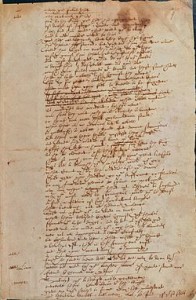 Sir Thomas More’s Speech To The Mob
Sir Thomas More’s Speech To The Mob
Recently I was getting ready to teach a unit on ‘The Tempest’ and was trying to find material on how to link Shakespeare’s plays to the modern world. I thought I was fairly knowledgeable when it came to the Bard but stumbling upon a video of Sir Ian McKellen performing a speech written by good old Will, I found myself unable to identify the play it came from. Now there are plenty of plays I would not be able to identify many lines from but this speech resonated and I found it hard to believe I hadn’t heard it before. It was relevant to today, pithy and evocative. There was passion and it wasn’t just Sir Ian’s delivery.
Upon a little investigation the speech appeared to come from ‘The Booke of Sir Thomas More’, an Elizabethan play co-written by a number of celebrated play writes including Anthony Munday and Henry Chettle. They play was never fully finished and scholars argue over whether it was ever performed for the Elizabethan of Jacobean audiences. The speech I had heard is, however, attributed to William Shakespeare, one of many contributors to the script. The handwritten manuscript of this speech is the only example of his hand and is kept in the British Museum.
So, the speech. It is a cracker! On the May 1st 1519 a riotous group arrived in central London attacking foreigners who they believed had no place living in England. Thomas More was the Under-Sherif of London at the time and tried to calm them and warn them of the consequence of their actions. The speech is moving in its passion, full of lines that could be lifted and chanted at any rally you might attend on the steps at the top of Burke Street today. I found it hard to reconcile how such an eloquent discourse that is as relevant today as it was almost 500 years ago had gone unheard for so long. You really must read it – or better yet let the master give it a belting for you.
[youtube http://www.youtube.com/watch?v=AjEAeOshUGQ&w=560&h=315]
What can I say that is not self-evident within this piece? Let’s just say any room I teach in now has a copy plastered to the wall. It will become a hallmark of my introduction to Shakespeare and required study in my school.

